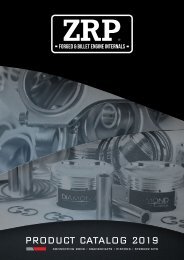ZRP_Catalog_2017
Create successful ePaper yourself
Turn your PDF publications into a flip-book with our unique Google optimized e-Paper software.
technical | Installation instructions | Billet Crankshaft<br />
4. Check end float (Thrust clearance)<br />
It is advisable to check the thrust clearance at both thrust faces to ensure an accurate measurement.<br />
5. Main Bearings Alignment (IMPORTANT!)<br />
After you have finished with the bearing installation you have achieved proper oil clearance. You have to check<br />
the main bearing alignment. This must be done in a machinery workshop.<br />
6. Crankshaft Installation<br />
A. Clean the Crankshaft very well, after that blow with dry air to clean oil holes thoroughly. Make sure oil holes<br />
are flow free!<br />
B. Inspect all journals to make sure the crank is free of nicks, scratches, and hairline cracks.<br />
C. Spread plenty of oil on all journals before assembly. Do not lubricate the thrust faces of the thrust bearing at<br />
this point.<br />
D. Check proper oil clearance and make sure the direction of rod and bearing are corrected. A 0.50mm-<br />
0.715mm side clearance is required<br />
E. Once you have measured all your journals and matched them to their specific bearings, you are ready to<br />
lay the crank in place. Before doing that, however, spread a coat of assembly grease on the bearings to<br />
protect the crank.<br />
F. Now position the crank on the block without installing any of the caps, just yet. Install a dial indicator on the<br />
nose of the crank to measure endplay. You should be able to move the crank back and forth by hand. The<br />
clearance must be as suggested by the engine’s manufacturer.<br />
G. When you make sure you have the correct amount of endplay, go ahead and install the rear main seal before<br />
bolting on the main cap.<br />
H. The next step is to bolt up and torque all the main cap except for the cap containing the thrust bearing.<br />
Make sure you add oil on the thread of the bolts first. Check your endplay again. If you don’t have enough<br />
play, one of the caps is out of alignment. You can adjust the cap location slightly by tapping it lightly with a<br />
dead-blow hammer and then tightening the bolts back down.<br />
I. Again, if the endplay is correct, you can install the last main cap-this one with the thrust bearing. Tap it into<br />
place but do not torque the cap bolts. Instead, knock the crank lightly, either forward or back, to align the<br />
thrust faces of the two bearing shells. Now tighten the bolts to the proper torque specs.<br />
J. Once you have reached this point, most probably the end play has tightened up a bit. You can use a screwdriver<br />
placed between one of the main caps and a counterweight to help you move the crank. Be careful<br />
and do not use excessive force. If there isn’t enough endplay, you may need to reduce the thickness of the<br />
thrust face of the thrust bearing slightly. This can usually get you a thousandth or so. Lightly rub both faces<br />
of both halves of the thrust bearing on super-fine sandpaper that is being lubricated by a constant stream of<br />
fluid in your cleaning tank. It’s also a good idea to use a surface block (or even a pane of glass) underneath<br />
the sandpaper to make sure you are sanding on an even plane. If the endplay is too much, you must use<br />
oversized thrust washers.<br />
We “strongly” recommend that you balance the crank and flywheel together.<br />
All 4340 cranks are nitrited with plasma gas. DO NOT polish journal in any circumstances.<br />
Stroker Kit<br />
Installation instructions<br />
Please read installation thoroughly before starting work. When they are completely understood proceed<br />
with installation<br />
1. Clean and prepare the engine block<br />
Please clean carefully the engine block and all components to ensure perfect bearing placement. By far the best way to<br />
remove all gallery plugs and all the dis-assembled engine to soak in a agitated chemical bath. This way all the sludge and<br />
dirt accumulations are removed. If chemical cleaning facilities are unavailable, you can use the less desirable method with<br />
a solvent such as Kerosene. It is imperative to ensure that the entire lubrication system is completely clean and free of<br />
obstructions.<br />
2. Check NIP and back contact<br />
It is necessary to check the NIP or crush fit of the new bearings in their housing and also the back contact if the old bearing<br />
backs have any bright, shiny areas. The procedure of this operation is:<br />
A. Apply a coating of the bearing “blue” to the cleaned tunnel seating and the joint faces of the case or cup<br />
B. Clean and try the bearings and apply the bearing “blue” to the joint faces on one bearing. Assembly the bearings in to<br />
the housings, tightening the holding bolt evenly to the correct tension. Threads should be oiled.<br />
C. Accurately measure and right down the assembled internal diameters of each pair of bearings, then release the bolt or<br />
bolts on one side only. This should allow the joint faces to separate on this side. A feeler guide of 0.10mm to 0.15mm<br />
should be accepted into the opening.<br />
D. Release the remaining bolts and dismantle the bearing unit completely. An examination of the housings and the bearings<br />
should reveal an even transference of “blue”<br />
i. Tunnel bores to back of bearings<br />
ii. One bearing joint face to the other<br />
iii. The cap joint face to the case joint face or vice-versa<br />
An uneven transference of blue indicates some “off standard” condition to be investigated and corrected.<br />
3. Check oil clearance<br />
With tunnel sizes correct to specification and shaft journal unworn or correctly ground undersize, ACL finished-to-size<br />
bearings will provide a correct operating clearance which can be quickly confirmed on assembly with the use of flexi<br />
gauge. Where doubt exists, or in special case, oil clearance should be checked by accurately measuring and writing down<br />
each journal diameter and then subtracting this from the corresponding internal bearing diameters that where noted when<br />
checking the amount of nip. The difference between the two diameters represents the vertical oil clearance and this<br />
must fall within the specified tolerance shown against each part number in the alphabetical list.<br />
technical | Installation instructions | Stroker Kit<br />
26 27





